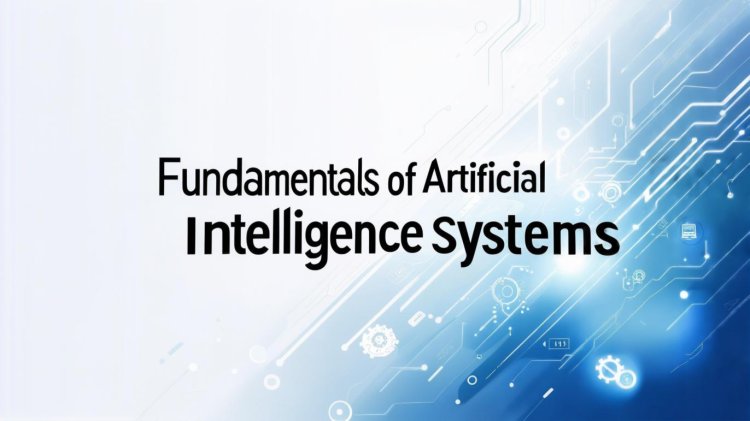Fundamentals of Artificial Intelligence Systems
Fundamentals of Artificial Intelligence Systems. How Technologies Change Our Future and Everyday Life!

Artificial intelligence (AI) is one of the most exciting areas of modern technology. It covers a wide range of areas and offers solutions that change the way we approach everyday tasks. In this article, we will look at the basics of AI systems, how they work, their main components, and their applications.
What is artificial intelligence?
Artificial intelligence is the ability of machines to perform tasks that in the past required human intelligence. These tasks include speech recognition, decision making, natural language understanding, and even learning from experience. AI aims to create systems that can mimic human behavior and improve their actions based on data.
Types of Artificial Intelligence
There are several types of artificial intelligence. The main ones are:
1. Narrow AI. These are systems that specialize in performing one specific task. For example, facial recognition programs or chatbots.
2. General AI. This is a hypothetical system that can perform any intellectual tasks that a human can perform. At the moment, such AI has not yet been created.
3. Superintelligence. This is a level of intelligence that exceeds that of humans. It can solve problems that are beyond the reach of the human mind. This is also a subject of debate and theoretical research.
How does artificial intelligence work?
The basic principles of AI can be explained through several key components:
1. Data
Data is the basis for training AI systems. The more and more diverse the data, the more accurate and effective the models will be. Data can be structured (e.g. tables) or unstructured (texts, images, videos).
2. Algorithms
Algorithms are sets of rules and instructions that help analyze data. They determine how a system will learn and make decisions. There are many algorithms, including:
– Machine learning. Systems learn from data to make predictions or decisions without being explicitly programmed.
– Deep learning. This is a subcategory of machine learning based on neural networks. It allows models to process complex data, such as images and audio.
3. Models
A model is the result of training an algorithm on data. It is used to perform specific tasks. For example, a model can be trained to recognize objects in images or predict future events based on historical data.
Application areas of artificial intelligence
Artificial intelligence is used in a variety of areas. Here are some examples:
1. Healthcare
In medicine, AI helps diagnose diseases by analyzing medical images and patient data. Systems can predict diseases at early stages, which significantly increases the chances of successful treatment.
2. Financial services
In the financial sector, AI is used to analyze market data, assess customer creditworthiness, and identify fraudulent transactions. Algorithms can process vast amounts of information and find patterns that are inaccessible to human analysis.
3. Automotive industry
In the automotive industry, AI plays a key role in the development of autonomous driving systems. Machines equipped with AI can analyze the environment, make decisions, and control the movement without human intervention.
4. Education
Artificial intelligence is also finding applications in educational technology. Systems can adapt to students’ needs, offering personalized learning plans and resources.
5. Production
In manufacturing, AI optimizes processes, predicts equipment failures, and improves efficiency. This helps reduce costs and increase productivity.
Ethical aspects of artificial intelligence
As AI advances, ethical questions also arise. The impact of technology on society must be considered. For example, how to protect users’ personal data? How to avoid bias in algorithms? These questions require careful consideration and discussion.
The problem of bias
One of the key concerns is that algorithms can inherit biases present in training data. This can lead to unfair decisions, for example, in lending or hiring. Therefore, it is important to use diverse and representative data when training models.
Transparency
Another important aspect is the transparency of algorithms. Users should understand how decisions are made and what the AI’s conclusions are based on. This will help establish trust in the technology.
The Future of Artificial Intelligence
The future of artificial intelligence looks very promising. The technology is expected to continue to evolve, becoming more sophisticated and accessible. We can expect new applications in a variety of areas that will change the way we live.
Integration with other technologies
One of the key areas will be the integration of AI with other advanced technologies such as blockchain, the Internet of Things (IoT), and quantum computing. This will open up new horizons for the application of AI and allow for the creation of more complex and powerful systems.
Sustainable development
Another important aspect will be the use of AI to solve global problems such as climate change, healthcare and education. The technology can help develop sustainable solutions that will contribute to improving the quality of life on the planet.
Conclusion
Artificial intelligence is a powerful tool that is already having a significant impact on our lives today. Understanding the basics of AI systems will help us better understand their potential and risks. As technology advances, we will face many new challenges and issues related to ethics and safety. However, one thing remains constant: AI will continue to evolve and open up new horizons of possibilities. Basics of Artificial Intelligence.
P.S. “All the tips (prompts) for GhatGPT presented on this site are free and are intended for informational purposes only.
Please note that in case of financial losses during the use of these materials, the owner of the site is not responsible. You, as a user, use the tips (prompts) for GhatGPT at your own risk.”
Share
What's Your Reaction?
 Like
0
Like
0
 Dislike
0
Dislike
0
 Love
0
Love
0
 Funny
0
Funny
0
 Angry
0
Angry
0
 Sad
0
Sad
0
 Wow
0
Wow
0





![Transfer/ Postings Senior Superintendent Police Hyderabad [Notifications]](https://pakweb.pro/uploads/images/202402/image_100x75_65d7bb0f85d5f.jpg)
![Amazing Text Animation Effect In CSS - [CODE]](https://pakweb.pro/uploads/images/202402/image_100x75_65d79dabc193a.jpg)






